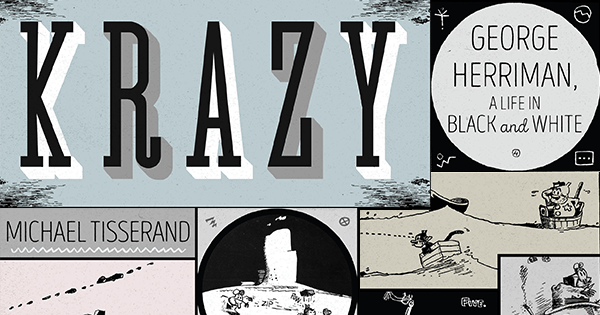
What do Bill Waterson, E. E. Cummings, Fritz Lang, and Charles M. Schulz have in common? They’re just a few famous fans of one of the most influential comics in history—George Herriman’s Krazy Kat, which ran from 1913 to 1944. The series, which took as its subject the hijinks of a gender-amorphous cat and the disgruntled mouse s/he loves, was one of the first of its form to be taken seriously by newspaper readers and critics alike. And as Michael Tisserand shows in this excerpt from Krazy, his expansive new biography of the man behind the marker, the comic’s influence can be seen in all the artistic realms that surrealism touched, on both sides of the Atlantic.
As he received adulation in the New York press, Herriman was being embraced as a kindred soul by native and expatriate writers and artists in Paris, who eagerly passed around Krazy Kat comics as they were developing their ideas about surrealism.
The entrance of Krazy Kat into postwar Paris art and literature circles can be traced directly to E. E. Cummings. During World War I, Cummings volunteered as an ambulance driver; on a ship to France he met fellow volunteer William Slater Brown. The two men were imprisoned in Normandy for voicing antiwar opinions, and Brown eventually joined the circle of Harvard graduates—which included Cummings, Seldes, Summerfield Baldwin, and painter Edward Nagle—who devotedly followed the movements of Krazy Kat and Ignatz.
After the war, Cummings was in Paris, penning letters home from various hotels and restaurants, thanking Nagle and Brown for sending him “The Krazies.” These comics were jealously guarded. “Thank you moreover for a Kat of indescribable beauty,” he wrote Brown. In another letter, he added, “The batch which G. Seldes brought over he wanted to put with his own collection, so I let him—keeping the later arrivals myself, as you direct.” In many of his letters, Cummings added lines such as “many thank youzes.” Over time, this mimicry of Krazy Kat’s voice would carry forward into Cummings’s own verses.
The circle of fans widened when Columbia University student Matthew Josephson traveled to Paris to make his way as a poet, befriending writer Louis Aragon. Josephson and his new friends were fond of raising hell in the public square, getting drunk and standing on chairs to recite Hugo or read from German socialist tracts. In quieter moments they reflected on the latest treasures of the comic page. Josephson later recalled how he furnished Aragon and writer Philippe Soupault with “a goodly store of recent ‘Americana’ in the form of ‘Krazy Kat’ cartoon serials by George Herriman.”
The surrealists celebrated in Krazy Kat the complexities that some other newspaper readers were lamenting. Herriman layered Krazy Kat in visually and verbally dense allegories of fate and free will, good and evil, and reality and illusion:
KRAZY KAT: And as for that “rock,” hoh-chee I fear it not—it’s a mere drawing—a mere harmless delineation—
IGNATZ (looking at reader): Somebody’s told that “cat” something.Herriman persisted in his interrogations. He toyed with notions of identity and social status, mixing up a swan for a duck, or a rash-covered lark for a robin redbreast. He switched out Krazy and Ignatz’s colors nearly as often as he did the cacti of Coconino. Some comics explicitly dealt with race—or as explicitly as possible in an all-animal comic. In one strip Ignatz awakens by the sea, having “worked up an elegant coat of tan.” Krazy, upon seeing the darkened Ignatz, offers a rare brick toss, with the line, “Dagnabya!!! Dunt think I’m no ‘Desdeamonia’ you Otello.”
In another, Krazy Kat’s tail betrays kinks similar to those in the hair that hid beneath Herriman’s hat. “Gosh!!! What a kinky tail,” Ignatz says. “Kinky my elbow,” says Krazy, “I just had it marcelled.” “Marcelled” referred to using hot tongs to straighten curly hair or create a wave; at the time this comic appeared, dancer Josephine Baker was famously sporting the style in the Broadway musical Shuffle Along.
There are gags about “li’l Eetiyopian mice” and a “koffa-kullid kickipoo.” Ignatz turns black and is shunned by Krazy. Krazy turns white and Ignatz becomes infatuated. In another comic, a black Ignatz and a white Krazy Kat regard themselves in shock as they slowly transform back to their original colors. Then they awaken in bed together, having just shared the same dream.
Such dream logic was championed by writer André Breton, a close colleague of Aragon and Soupault’s, when he penned his first “Manifesto of Surrealism” in 1924. “Surrealism is based … in the omnipotence of dream, in the disinterested play of thought.”
So was Coconino:
KRAZY: Eft all, ‘Ignatz, what’s it all about anyhow?
IGNATZ: What?
KRAZY: I esk you, what’s life?
IGNATZ: Only a dream, I’d say
KRAZY: Yes—and what’s a drim?
IGNATZ (throwing brick): Aah—shux, you want to know too dern much.In later years Krazy Kat would frequently be discussed in terms of surrealism. Yet the surrealists were trading on the sort of imaginative wordplay and visual audacity that had been in comics for years, and had specifically been turning to Krazy Kat itself for inspiration. Perhaps, as comics scholar Mark Newgarden has suggested, it might be more appropriate to call the work of the surrealists “krazy.”
From the book Krazy by Michael Tisserand. Copyright © 2016 by Michael Tisserand. Reprinted courtesy of Harper, an imprint of HarperCollins Publishers.


